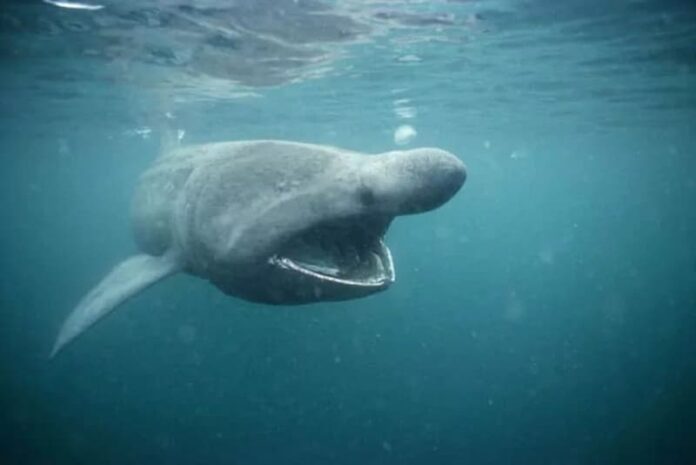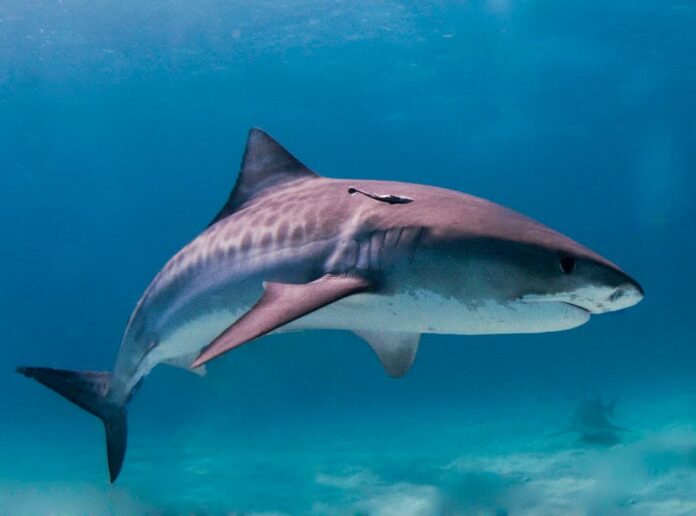One of our biggest fears when swimming is definitely the jaws, and knowing that some of the largest sharks can be dangerous is fearsome. The good thing is that not all sharks are dangerous despite their intimidating size. You will find the 10 largest sharks in the list below, so let’s take a look and see what they are.
10Greenland Shark

Length: 2.5 – 4 meters (6.5 – 13 feet)
Here you are looking at one of the long-living sharks and the longest-living vertebrates in the world. Some individuals can live up to over 300 years old or older, and their lifespan is estimated to be at least 500 years. It wouldn’t be a surprise if you know that Greenland sharks reach sexual maturity at around 100 years of age. The older they get, the longer they become and the longest ever recorded was 7 meters (23 feet). You can find them in the North Atlantic Ocean, especially near Canada, Iceland, and Norway.
Greenland sharks are not picky eaters, and they eat anything they can find no matter if it is alive or dead. These sharks are absolutely docile and harmless to humans, but their meat is poisonous. Their flesh contains neurotoxins from trimethylamine oxide (TMAO) that help the fish to stabilize their enzymes and structural proteins. That way, these sharks can live and swim against the effects of high water pressure and severe cold water. You can consume their meat if it is properly prepared in a fermentation process that removes the TMAO.
9Thresher Shark

Length: 3.3 – 4.5 meters (10.5 – 14.8 feet)
You can tell right away when you spot a thresh shark due to the size of its enormous tail. The tail is so long that sometimes its length is as long as the shark itself. This large tail helps them to stun small schooling of fish during hunting and to swim fast in the water. Despite the ability to leap out of the water and swim fast, thresher sharks are harmless, timid, and shy around humans. Thresher sharks live in both deep and shallow waters in the Indian and Pacific Oceans.
The fascinating thing about them is that they have electroreceptors that allow them to detect electrical impulses from living creatures. On top of that, these sharks have an extraordinary heat exchanger system that allows them to produce heat through their internal body mechanism. People hunt thresher sharks for their fins for soup, hides for leather, liver oil for vitamin processing, and meat. There are 3 species of thresher sharks, and they are now listed as vulnerable due to over-fishing.
8Pacific Sleeper Shark

Length: 3.7 – 4.3 meters (12. 1 – 14.1 feet)
This species is a deep water dweller, and they are found in temperate waters in the North Pacific and South Pacific. These sharks have spear-like upper teeth and slicing lower teeth with low-bent cusps and high roots that produce powerful bites. In case the food is too large to swallow, their teeth also help to saw it through for easier consumption as well. The Pacific sleep sharks feed on bottom fish, octopuses, squids (including giant squids), and sometimes sea lions and seals. Sometimes food is scarce on the deep sea floor, so these sharks store food in their capacious stomach. That way, they can store extra energy for fast and violent bursts to catch prey when it is available. Because they live in the deep sea, their only preys are killer whales.
7Tiger Shark

Length: 3.25 – 5 meters (10.6 – 16.4 feet)
Received its name from the dark vertical stripes on its body, a tiger shark is an aggressive and ferocious predator. These man-eaters inhabit temperate and tropical waters, and this species has the reputation of common attack on people. Tiger sharks have an excellent sense of sight and smell, and their powerful jaws help them to hunt. Unlike the great white sharks, this one does not swim away after biting people.
As scavengers, they eat pretty much anything from birds and shellfish to turtles and more. Another nickname is garbage eater because these sharks also eat metal, wood, and other inedible man-made items. Some large individuals can grow as long as 8 meters, making them one among the largest sharks. Tiger sharks have extremely low population rates, and their main threats are overfishing for fins, flesh, livers, and skin.
6Bluntnose Sixgill Shark

Length: 4.8 – 5.5 meters (16 – 18 feet)
Found in temperate and tropical waters, bluntnose sixgill sharks are another deep-water shark species and one of the largest sharks. They are found in the continental and island shelves of the Atlantic, Indian, and Pacific Oceans. They spend most of their time at the depth of the sea which is about 4,500 feet below the ocean’s surface. Just like the name suggests, the species has 6 pairs of long gill slits on each side of its broad head. The bluntnose sixgill sharks are slow but strong swimmers, and they are also fierce hunters of the ocean. On top of that, they are known to feed on each other if the opportunity allows them to. As deep-sea dwellers, there are still mysteries and unknown information about this species.
5Megamouth Shark

Length: 4.5 – 6 meters (14.7 – 19.6 feet)
Although rare, megamouth sharks are one of the largest sharks in the world. However, it is the smallest among the 3 species of filter feedings sharks in the ocean. As you can see, this shark species has a large circular mouth that allows filtering through the water. This allows them to catch their favorite meals which are jellyfish, krill, and plankton as they swim. Megamouth sharks are wide-ranging, and they are found in the Atlantic, Indian, and Pacific Oceans. The largest megamouth shark ever recorded was off the California coast with a length of up to 7.6 meters (25 feet). Because they are non-aggressive and slow swimmers, these sharks are often attacked by other fish. Commercial fishers do not target them, so humans are not their threats.
4Great Hammerhead Shark

Length: 4.6 – 6.1 meters (15 – 20 feet)
There are 9 species of hammerhead sharks, and the great hammerheads are the largest. These sharks are apex predators, and their habitats are worldwide in coastal and warm waters. Just like some shark species, this one is also solitary and it migrates long distances alone. Just like thresher sharks, these sharks also have electrical receptors on their heads that allow them to sense potential prey. Even if the prey hides in the sand, they cannot escape from these ferocious predators. This is why the great hammerhead sharks can feed on prey on the ocean floor such as cephalopods, crustaceans, stingrays, etc. This species is not endangered due to over-fishing for their large fins in the global shark fin trade.
3Great White Shark

Length: 4.5 – 6.4 meters (14.7 – 20.9 feet)
The great white sharks are not only among the largest sharks but also the most dangerous sharks in the world. Also, they are also one of the fast swimmers thanks to the powerful tails that help them to propel through the water. These ferocious hunters feed mostly on mammals like dolphins, porpoises, seals, and sometimes fish like sharks and rays. With up to 300 serrated triangular teeth arranged in several rows and an incredible sense of smell, finding food is easy for them.
Great white sharks live in cool coastal waters around the world, and they do bite people. The interesting thing is that despite a lot of attacks on humans, great white sharks swim usually away after one bite. Sometimes that one exploratory bite can be a scary experience although not fatal, and that is why people fear them. On the other hand, it is the people who capture too many of them; hence the threat to their population.
2Basking Shark

Length: 6 – 8 meters (19.6 – 26.2 feet)
Looking scary at all with that large mouth, a basking shark is actually very docile and harmless. It is true that their mouths are big enough to swallow us whole, but they have no interest in eating humans. At the same time, basking sharks lack sharp teeth and they are not aggressive or dangerous at all. Out of curiosity, basking sharks sometimes calmly circle groups of divers and snorkelers in the water. As filter feeders, the size of their mouths helps them to catch plankton easily.
A basking shark spends most of its time near the water’s surface, swimming with their mouth open to eat plankton. These harmless sharks often swim in pairs or large groups of up to 100 individuals, and sometimes they swim alone. A female basking shark has a gestation period of at least 3 years, and gives birth to hundreds of pups. These sharks have massive livers, and people hunt them for their livers to sell in Japan. Their biggest threats today are accidental by-catches, demands for their fins for shark fin soup, and over-fishing.
1Whale Shark

Length: 5.5 – 12 meters (18 – 39 feet)
Whale sharks are the largest sharks living in the world today, and they have a docile nature. A full-grown whale shark can grow as long as 18 meters (62 feet), but this enormous size is not so common. You can recognize a whale shark by its unique dark gray skin color and white spots on its upper body. Also, they have a flat and wide head with two small eyes at the front corners. You can find them in all tropical seas, and you can also swim with them if you see one.
These harmless giants feed on small fish and tiny plants, and their favorite meal is plankton. Their feeding method is called “filter-feeding”, and it does this by opening its mouth and swimming forward. Whale sharks are ovoviviparous, and a female whale shark can give birth up to 300 pups. This species is now considered endangered due to by-catch losses, the impacts of fisheries, and vessel strikes.
Related Post: Harmless Sharks You Can Swim With




